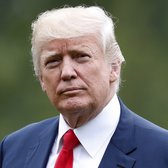More than 5 million Syrians have fled their country since 2011, and more than 6 million are displaced from their homes internally, according to the United Nations.
To protect them, President Donald Trump promised during his campaign that he would establish "safe zones" in Syria, rather than bringing them to the United States..
Since Trump took office, there has been talk about plans to establish conflict-free regions to house displaced Syrian civilians. But his administration has not made any measurable progress toward this goal during his first six months in office.
During Trump's first couple weeks in office, the White House said he asked the kings of Saudi Arabia and Jordan to support safe zones in Syria. A few months later, the White House said he discussed the issue with Russian President Vladimir Putin.
"What I want to do is build safe zones in Syria and other places so they can stay there and live safely until their cities and their country, that mess that I was left by Obama and everybody else — folks, we were left a mess like you wouldn't believe, but we're going to build safe zones," he said in a Feb. 18 speech in Florida.
He said in the same speech that he would make the gulf nations pay for the safe zones.
Russia, Turkey and Iran established four "de-escalation zones" in Syria in early May, but that's separate from U.S. efforts.
The United States and Russia — which support opposing sides in the Syrian conflict — agreed to a ceasefire in southwest Syria July 7, but it's unclear whether the ceasefire agreement establishes any additional safe zones specifically for refugees.
"No one's quite sure what the status is," said Robert McKenzie, director of the Muslim Diaspora Initiative at New America, a think tank.
Based on his conversations with government employees working on the Syrian refugee issue, McKenzie said it doesn't appear that the White House has worked on a serious proposal.
He added that Trump has yet to nominate an assistant secretary for the State Department's Bureau of Population, Refugees and Migration, who would likely oversee safe-zone policy development.
Establishing safe zones is difficult because it raises a host of prickly questions, McKenzie said. Like: How do you protect the safe zone from bombings? How do you police the region so it doesn't become a hotbed for extremist group recruitment? And how do you get the displaced people to the safe zone?
President Barack Obama's administration shied away from establishing safe zones in Syria because of these concerns, along with the desire to avoid getting entrenched in a foreign conflict like the wars in Iraq and Afghanistan, McKenzie said.
We should also note that in March, Secretary of State Rex Tillerson said he wanted to establish an "interim zone of stability" for civilians displaced by the Islamic State. But State Department spokespeople told reporters at the time that this was separate from Trump's promise to establish safe zones for victims of the Syrian civil war.
The White House has said Trump is still interested in establishing safe zones, as recently as June 20. But because we don't really see the administration putting the wheels in motion yet, we rate this promise Stalled.




